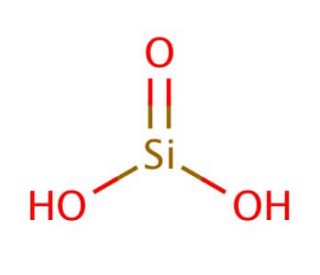
Click on image or enlarge button to enlarge

Silicic acid: sc-229290
Silicic acid (CAS 1343-98-2)
Application:
Silicic acid is a silanol able to inhibit aluminum uptake
CAS Number:
1343-98-2
Molecular Weight:
78.11
Molecular Formula:
H2SiO3
For Research Use Only. Not Intended for Diagnostic or Therapeutic Use.
* Refer to Certificate of Analysis for lot specific data.
QUICK LINKS
Ordering Information
Description
Technical Information
Safety Information
SDS & Certificate of Analysis

Silicic acid is a silanol found in the ocean, where its levels are regulated by diatoms. It may be useful for studying neurodegenerative diseases due to its ability to inhibit aluminum uptake.
References:
- Silicic acid: its gastrointestinal uptake and urinary excretion in man and effects on aluminium excretion. | Reffitt, DM., et al. 1999. J Inorg Biochem. 76: 141-7. PMID: 10612067
- The effect of different concentrations of silicic acid and silica dust on the biosynthesis of collagen in tissue cultures. | CHVAPIL, M. and HOLECKOVA, E. 1959. Br J Ind Med. 16: 286-9. PMID: 13810239
- A study of the alumina-silica gel adsorbent for the removal of silicic acid from geothermal water: increase in adsorption capacity of the adsorbent due to formation of amorphous aluminosilicate by adsorption of silicic acid. | Yokoyama, T., et al. 2002. J Colloid Interface Sci. 252: 1-5. PMID: 16290755
- Sorption of selenium(IV) onto magnetite in the presence of silicic acid. | Jordan, N., et al. 2009. J Colloid Interface Sci. 329: 17-23. PMID: 18947836
- Competition between selenium (IV) and silicic acid on the hematite surface. | Jordan, N., et al. 2009. Chemosphere. 75: 129-34. PMID: 19110295
- Glacial silicic acid concentrations in the Southern Ocean. | Ellwood, MJ., et al. 2010. Science. 330: 1088-91. PMID: 20966217
- Silicic acid in drinking water prevents age-related alterations in the endothelium-dependent vascular relaxation modulating eNOS and AQP1 expression in experimental mice: an immunohistochemical study. | Buffoli, B., et al. 2013. Acta Histochem. 115: 418-24. PMID: 23177919
- Silicic-acid uptake in diatoms studied with [(68)Ge]germanic acid as tracer. | Azam, F. 1974. Planta. 121: 205-12. PMID: 24442800
- The effect of silicic acid on calcium phosphate precipitation. | Damen, JJ. and ten Cate, JM. 1989. J Dent Res. 68: 1355-9. PMID: 2550533
- Interrelationship between hemolysis and lipid peroxidation of human erythrocytes induced by silicic acid and silicate dusts. | Singh, SV. and Rahman, Q. 1987. J Appl Toxicol. 7: 91-6. PMID: 3040843
- Silicic acid limitation drives bloom termination and potential carbon sequestration in an Arctic bloom. | Krause, JW., et al. 2019. Sci Rep. 9: 8149. PMID: 31148569
- Colloidal Dynamics of Freshly Formed Iron Oxides under the Influence of Silicic Acid. | Dam, TTN., et al. 2019. J Environ Qual. 48: 670-676. PMID: 31180432
- Structural Basis for Silicic Acid Uptake by Higher Plants. | van den Berg, B., et al. 2021. J Mol Biol. 433: 167226. PMID: 34487790
- Elevated ozone phytotoxicity ameliorations in mung bean {Vigna radiata (L.) Wilczek} by foliar nebulization of silicic acid and ascorbic acid. | Shahzadi, E., et al. 2022. Environ Sci Pollut Res Int. 29: 69680-69690. PMID: 35576036
- Computational modelling of diatom silicic acid transporters predicts a conserved fold with implications for their function and evolution. | Knight, MJ., et al. 2023. Biochim Biophys Acta Biomembr. 1865: 184056. PMID: 36191629